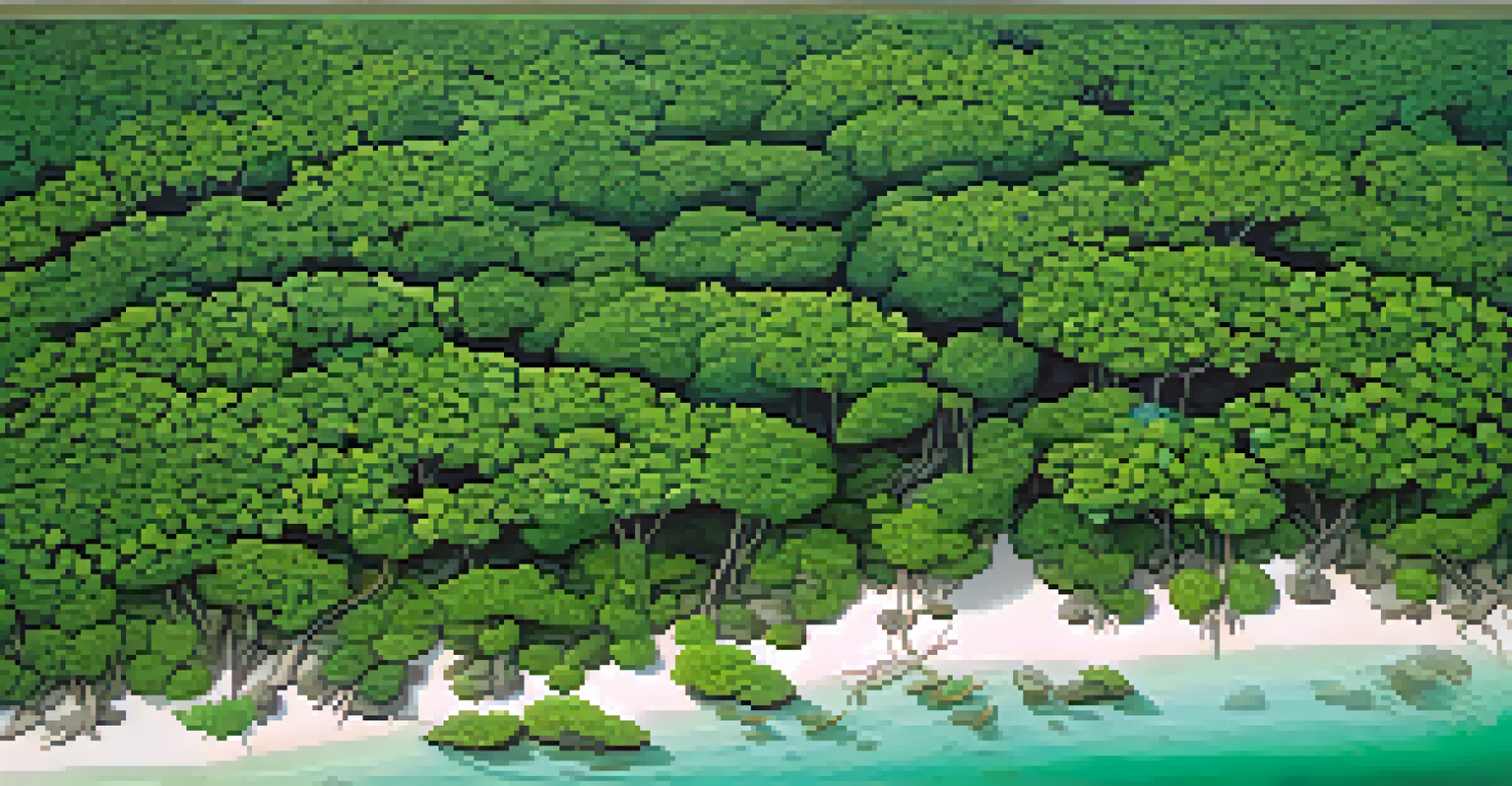Mangrove Trees: Adapting to Saltwater and Coastal Flooding

What Are Mangrove Trees and Where Do They Grow?
Mangrove trees are unique coastal plants that thrive in tropical and subtropical regions. They grow in intertidal zones, where saltwater from the ocean meets freshwater from rivers. This unique habitat allows them to flourish in conditions that many other trees cannot survive.
The greatest threat to our planet is the belief that someone else will save it.
Mangroves are characterized by their tangled roots, which provide stability in soft, muddy soils. These roots not only anchor the trees but also create a rich habitat for various marine species. Think of them as nature's own architectural marvel, designed to withstand the forces of nature.
You can find mangroves in over 123 countries, including the coasts of Florida, the Caribbean, and Southeast Asia. Their presence is crucial in maintaining the ecological balance of coastal areas, making them an essential part of our planet's biodiversity.
How Do Mangroves Adapt to Saltwater Conditions?
One of the most remarkable features of mangrove trees is their ability to tolerate high salinity levels. They have specialized root systems that filter out salt, allowing them to absorb freshwater. This adaptation is crucial, as it enables them to thrive in environments that would be inhospitable to most other plants.

Additionally, some species of mangroves can excrete excess salt through their leaves, essentially 'sweating' out the salt. This process is similar to how we sweat to cool down, but for mangroves, it’s a survival technique. These adaptations showcase the incredible resilience of these trees.
Mangroves Thrive in Coastal Zones
These unique trees grow in intertidal areas, flourishing where saltwater meets freshwater, creating vital ecosystems.
Moreover, mangroves have thick, waxy leaves that help retain moisture, further aiding their survival in salty environments. This ingenious combination of adaptations makes them one of the few tree species capable of thriving in such challenging conditions.
The Role of Mangroves in Coastal Flooding Protection
Mangrove trees play a vital role in protecting coastal areas from flooding and erosion. Their extensive root systems act like a natural barrier, absorbing wave energy and reducing the impact of storm surges. This function is particularly important in the face of climate change, where rising sea levels pose a significant threat to coastal communities.
In every drop of water, there is a story of life.
During heavy rains and storms, mangroves can also help absorb excess water, acting like a sponge. This capacity to mitigate flooding can protect homes, infrastructure, and ecosystems from devastating damage. Just imagine a sturdy shield standing guard against the relentless forces of nature.
In many regions, communities are recognizing the importance of preserving mangrove forests as a natural defense against flooding. By protecting these trees, we are not only safeguarding our coastlines but also promoting biodiversity and healthy ecosystems.
Biodiversity Supported by Mangrove Ecosystems
Mangrove ecosystems are incredibly biodiverse, serving as essential habitats for various species. Birds, fish, crustaceans, and even endangered species like the manatee rely on mangroves for shelter and breeding grounds. These trees create a unique environment that supports life both above and below the water's surface.
For instance, juvenile fish often find sanctuary within the roots of mangrove trees, where they can grow safely away from predators. This is akin to providing a safe haven for young ones until they're ready to venture out into the open sea. Such interactions highlight the importance of mangroves in marine life cycles.
Natural Flood Protection from Mangroves
Mangrove roots act as natural barriers, absorbing wave energy and mitigating coastal flooding, especially amid climate change.
Furthermore, mangroves also contribute to nutrient cycling in coastal waters, enhancing productivity. This not only benefits local fisheries but also supports the livelihoods of communities that depend on these resources. The intricate web of life within mangrove ecosystems is a beautiful example of nature's interconnectedness.
Threats to Mangrove Forests and Their Impact
Despite their resilience, mangrove forests face numerous threats, primarily due to human activities. Coastal development, pollution, and deforestation are leading causes of mangrove loss. When these forests are destroyed, the ecological balance is disrupted, resulting in severe consequences for both the environment and local communities.
Moreover, the loss of mangroves can lead to increased coastal erosion and decreased protection against flooding. Without these natural barriers, coastal areas become more vulnerable to the impacts of storms and rising sea levels. It's like removing a sturdy wall from a house – the structure becomes significantly weaker.
Conservation efforts are essential to protect and restore mangrove forests. By raising awareness about the importance of these ecosystems, we can encourage sustainable practices that help preserve them for future generations. Protecting mangroves is not just about saving trees; it's about safeguarding entire ecosystems and communities.
Restoration Efforts for Mangrove Conservation
Around the world, various initiatives are underway to restore mangrove forests and their vital functions. Restoration projects often involve planting new mangrove trees in areas where they have been depleted. This process not only helps to replenish lost ecosystems but also provides opportunities for community engagement.
Local communities play a crucial role in these restoration efforts. By involving them in planting and caring for mangroves, we foster a sense of ownership and stewardship over these vital ecosystems. It's a collaborative approach that can lead to sustainable environmental practices.
Threats to Mangroves Require Action
Human activities like coastal development and pollution jeopardize mangrove forests, highlighting the need for conservation efforts.
Successful restoration projects can result in healthier coastlines, improved biodiversity, and enhanced protection against climate change impacts. When we invest in restoring mangroves, we're essentially investing in the health of our planet and the well-being of future generations.
The Future of Mangrove Trees in a Changing Climate
As climate change continues to pose challenges worldwide, the future of mangrove trees is uncertain. Rising sea levels and increased storm intensity threaten these coastal ecosystems. However, their presence may also offer a glimmer of hope in mitigating some of these impacts.
Research is underway to understand how mangroves can adapt to changing climate conditions. By studying their resilience, scientists aim to develop strategies for conservation and restoration in the face of adversity. This proactive approach is essential for ensuring these trees can continue to thrive.

Ultimately, the fate of mangrove trees is intertwined with our actions. By prioritizing conservation and sustainable practices, we can help secure a future where mangroves continue to flourish, safeguarding our coastlines and supporting diverse ecosystems for years to come.